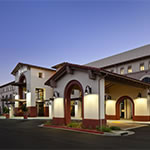In 2013, Facey Medical Group opened a $32.6 million, 124,059-square-foot clinic in Mission Hills, California, on the coast north of Los Angeles. The project became Southern California’s first medical office building larger than 120,000 square feet to receive LEED Gold certification.
The key to surpassing the original goal of LEED Silver? Technology. A building automation system tracks energy consumption in real time, accounting for the electrical, gas, water, and irrigation systems. Using a combination of energy-efficient fixtures, aluminum windows with shades, and daylighting, the facility is 23 percent more efficient than the national standard. Lighting plays a large role in that efficiency. Daylight sensors turn off light fixtures closest to windows when enough natural light is coming through, and occupancy sensors turn off lights in a space when it is not being used.
To improve indoor air quality, the team selected indoor plants from a list developed by NASA to remove pollutants from the air and improve breathing. For instance, an evergreen perennial known as mother-in-law tongue (sansevieria trifasciata) removes nitrogen oxide and formaldehyde from the air. The addition of a green cleaning policy ensures little odor and noise. Automatic chemical dispensers mix and dispense cleaning products, and automated scrubbing machines with variable-speed feed pumps and on-board chemical metering optimize the use of green cleaning fluids.
Recycling and reuse also were important. Facey Medical Group retained asphalt and concrete from the site’s former building and used it as fill material for the new asphalt. Nearly 25 percent of building materials, by value, were manufactured using recycled materials, and Facey Medical Group diverted 95 percent of construction waste from landfill.
The facility’s parking lot slopes toward 14 porous concrete sections that filter rainwater before it is directed into the city’s system. These filtration points are composed of five layers: porous concrete, aggregate base, woven filter fabric, filter material, and perforated PVC wrapped in filter fabric. They treat 90 percent of rainfall, removing 80 percent of total suspended solids.
All landscaping—including 200 new trees—was done entirely with native plants and decorative mulch rather than grass. The drip irrigation system uses ground-moisture sensors to water plants only when the soil has become too dry, reducing water consumption by 59 percent compared to baseline. The hot California climate also increases the heat island effect, so in order to minimize impacts on microclimates and human and wildlife habitats, Facey Medical Group installed reflective roofing on 81 percent of its roof.
To education staff and visitors, signs explain how the building is reducing its impact on the environment. Water bottle-filling stations on every floor provide filtered water to discourage the use of disposable bottles, and interactive walls located on each floor let visitors see real-time information about energy consumption. Visitors might also learn that the facility was built with materials that minimize negative health impacts. Zero-VOC paints by Dunn Edwards were used throughout the building, and you won’t find urea-formaldehyde resins in any laminate adhesives.
“Mission Hills is Facey’s flagship location, and we really thought a lot about what this building meant to us,” says Tracy Takeyama, the strategy and planning project manager for Facey Medical Group. “It was important for us to say that not only are we caring for people’s health, but we’re also caring for the health of our buildings.”

